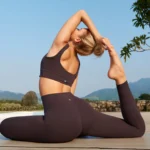Many people around the world enjoy yoga for flexibility, stress relief, and physical fitness. Over time, new styles of yoga have emerged to help individuals reconnect with their minds and bodies. One of the most transformative forms is somatic yoga, a method focused on awareness, internal movement, and nervous system healing. It is a gentle yet powerful practice that helps people release chronic tension from the inside out.
What Is Somatic Yoga
Somatic yoga is a therapeutic approach that combines traditional yoga movements with somatic awareness techniques. The term “somatic” comes from the Greek word soma, meaning “the living body from within.” The focus is on how the body feels, rather than how the pose looks.
While many yoga styles concentrate on stretching and posture perfection, somatic yoga emphasizes slow, mindful movements that teach the body to release deeply held muscle patterns and stress.
The Core Idea
• Move with intention
• Feel every sensation
• Allow the nervous system to relax and reorganize
Somatic yoga helps the brain learn new patterns of movement that support ease and comfort instead of tension and pain
How Somatic Yoga Works in the Body
The human body stores tension from stress, trauma, posture habits, and repetitive movements. Over time, these patterns become unconscious and cause discomfort, pain, or stiffness. Somatic yoga brings awareness to these areas, allowing the body to gently unwind.
Releasing Stress from the Nervous System
Somatic yoga activates the parasympathetic nervous system, also known as the “rest and digest” mode. This helps:
- Lower stress hormones
- Improve breathing and relaxation
- Calm the mind and reduce anxiety
Instead of forcing muscles to stretch, somatic yoga invites them to let go naturally
Key Principles of Somatic Yoga
This style is based on gentle guidance rather than force. A few principles make it unique:
Internal Focus Over External Shape
People are encouraged to close their eyes and notice how each movement feels. This creates a deeper connection between brain and body.
Slow Movements for Greater Awareness
When movement slows down, hidden tension becomes easier to identify and soften.
Comfort and Safety Above Everything
Pain is not a part of yoga. Movement stops before strain happens, giving the body a safe space to heal
Benefits of Somatic Yoga
Somatic yoga offers both physical and emotional benefits. Many people choose it because they struggle with stiffness, anxiety, or unexplained body pain.
Physical Improvements
• Better posture
• Increased flexibility without force
• Relief from chronic muscle tension
• Better balance and movement control
Somatic yoga can also help individuals with neck stiffness, back pain, headaches, and even jaw tension.
Emotional and Mental Relief
The practice encourages calmness and reduces internal stress. People often feel lighter, more centered, and better connected to their emotions after sessions
Somatic Yoga and Chronic Pain Recovery
One reason yoga is growing in popularity is its success in helping people reduce chronic pain. Many pain issues come from neuromuscular habits rather than physical injury. By teaching the brain to move differently, the body begins to break these patterns.
Helpful for Common Conditions
• Lower back pain
• Scoliosis discomfort
• Shoulder and hip tension
• Muscle pain from stress
• Fatigue-related issues
This makes yoga ideal for individuals who want a gentle, accessible pathway to recovery
Who Should Try Somatic Yoga
Yoga is suitable for people of all ages, fitness levels, and mobility conditions. It is especially helpful for:
• Office workers sitting long hours
• Athletes with tight muscles from training
• Seniors wanting gentle movement
• Individuals healing from trauma or stress
No advanced skills are required. A beginner can feel benefits from the very first session
How Somatic Yoga Differs from Traditional Yoga
Even though somatic yoga uses some yoga-based poses, the approach feels very different.
Comparison Highlights
• There is no pressure to stretch deeply
• Movements are often smaller and slower
• The priority is sensation, not pose structure
A person may spend more time lying on the floor than standing in a pose. Small adjustments can create big changes when the brain learns new habits
Somatic Yoga Practices and Techniques
Classes usually include breathing exercises, gentle flows, and guided awareness. Many movements begin in supported positions so the body can relax fully.
Here are a few common elements:
Pandiculation
A somatic technique where the body contracts slightly, releases gradually, and lengthens gently. It resets the neuromuscular system.
Guided Body Scanning
Participants notice sensations in different areas of the body to reconnect with muscles that have been ignored.
Micro Movements with Breath
Small shifts along with slow breathing help muscles unlock tension safely.
These techniques allow for deeper physical education rather than forced flexibility
Emotional Healing Through Somatic Yoga
The body stores memories and emotions. Yoga creates space to release emotional pressure that has been hidden inside muscles and nerves.
Some people report feelings of relief, clarity, or even tears after sessions. The emotional release is natural because the nervous system is finally letting go.
This makes yoga a valuable tool for individuals who want overall well-being, not just physical improvement
Practicing Somatic Yoga at Home
Anyone can begin with short sessions at home. A comfortable floor, slow movements, and mindful breathing are enough to start.
A helpful home approach includes:
• Move slowly and stop if the body resists
• Pay attention to sensations rather than appearance
• Allow breaks between movements for relaxation
A little daily practice can gradually change the way the body feels and functions
What to Expect in a Somatic Yoga Class
Classes usually take a calm, meditative pace. Teachers guide students through movements and help them pay attention internally. Props like yoga mats, blankets, and pillows are often used to increase comfort.
There is no competition, pressure, or complexity. Each person explores at their own rhythm
The Growing Popularity of Somatic Yoga
More physiotherapists, and psychologists teachers are recommending somatic methods. People want sustainable healing solutions for modern stress. yoga answers that need because it supports the body naturally, without intense exercise or strain.
It fits perfectly in a world where many individuals feel disconnected from themselves due to technology, fast pace, and mental overload
Conclusion: A Gentle Path Toward Whole Body Wellness
Somatic yoga offers a powerful reminder that the body can heal when given proper attention. It teaches people to move with awareness, release tension peacefully, and strengthen the mind-body connection. Instead of pushing the body hard, yoga invites kindness, softness, and curiosity.
Anyone seeking physical relief, emotional calm, or a deeper sense of balance can benefit from this mindful practice. The journey begins by slowing down, listening within, and allowing the body to guide the way.









